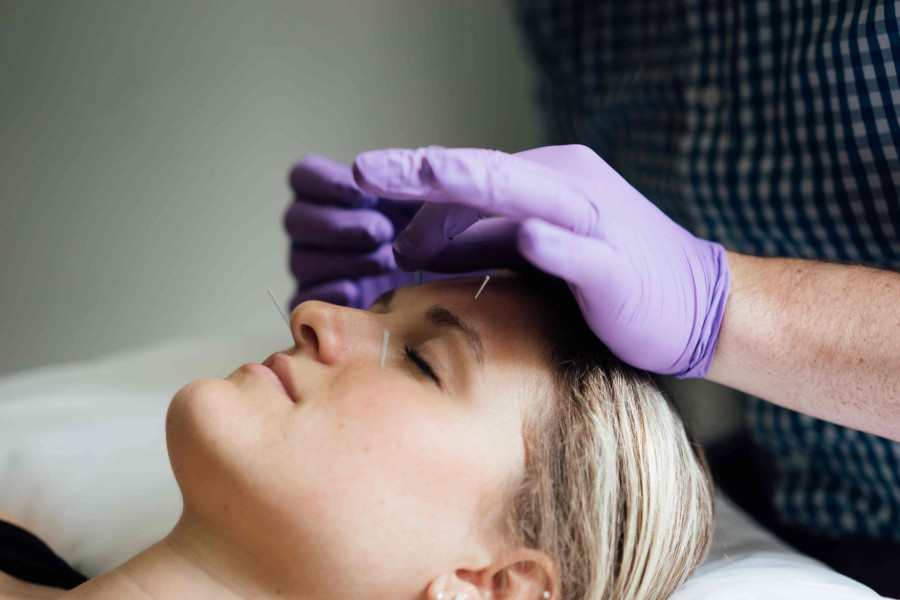Neuro-Reflexive Therapy – Dry Needling for Addiction Aftercare

I am lying on a wide padded table breathing in through a “hole in my head”. I am breathing out through my hands and feet. There are neuro-reflexive needles in my face, hands, ankles, hips, and the top of my head. And behind my eyes I see cobalt blue squares. When I tell the gentleman dry needling me that I am seeing colors, I feel tingly, he says, “Good. That’s good.” There is light pressure, he squeezes my head like he’s testing for ripeness in a fruit market. He says, “At the top of your breath there is dead space. Try to breath naturally, don’t force it.”
I thought I was just doing an interview on neuro-reflexive physical therapy in recovery…
There are two physical therapists now – Jesse Siwek, DPT; and Brandon Yuenger, DPT. They are part of a three-man team including Lucas Briggs, DPT who approached Sanford House from Grand Rapids Performance Center. They wanted to collaborate with us – using physical therapy as recovery aftercare. Hence this roving reporter’s first experience as a human pin cushion. I practice my breathing and I can tell which one is putting in the needle, pressing a muscle. One physical therapist is no-nonsense and the other intuitive – good cop, bad cop. On the inhale I smell lavender and eucalyptus. New age music begins to play. Someone presses my spine. I feel relaxed, warm.
During therapy we utilize all the senses. Memory is stored in the body – memory of pain, trauma, addiction, etc. And by involving as many markers as possible, we can reinforce patterns of change. Change starts to happen within… Jesse Siwek, DPT
A voice says, “I’m going to just leave you for a few minutes. Is that okay? Just relax…” And weirdly, I am as relaxed as I have ever been. But now there are circles of chartreuse behind my eyes, and patches of ultra-violet. A disjointed brick house floats by like the twister scene in the Wizard of Oz. I’m a little scared… I’m warm in the spots where I have been injured in the past – the top of my spine, my right hip…I can feel my left hand.
What is Neuro-Reflexive Physical Therapy?
I continue to breath, my panic subsides and soon Jesse re-enters. He plucks out needles, turn on the lights and lets the “real world” in. I tell him I felt scared. He says, “That is a typical reaction. But leaving you alone for a short time is key. I don’t want you to feel like I’m doing everything. Like this is being done to you.”
I get up from the table and Jesse watches me walk. I feel wider and taller – less creaky. Neuro-reflexive therapy is designed to help calm the nervous system and promote body awareness. Dry needling is based on western neuro-anatomy and scientific study. It involves inserting thin filament needles in order to stimulate the healing process of soft tissues. I am told neuro-reflexive therapy does not have to involve needles, but key pressure points unlock the unconscious coordination of the neuromuscular system.
In other words, the neuro-reflexive process calms the nerves.

Why Neuro-Reflexive Physical Therapy in Early Recovery?
So many reasons. At Sanford House, our first thought was for an alternative to those clients with chronic pain. And how those clients could manage pain without addictive drugs. But the team at Grand Rapids Performance Center reports good results helping to manage cravings. They also work with patients to improve overall physical performance and even help folks release tension and pain that is a result of unresolved grief or trauma.
Negative things happen up here (pointing to his head) and the body tries to shove it as far away as possible. But it doesn’t go away. It might settle in the back, hip or knee joints. It is not atypical for us to have a patient cry or experience vivid childhood memories when we work with a particular pressure point. Brandon Yuenger, DPT
Diagnoses that may benefit from physical therapy are:
- Post-traumatic or significant injury conditions
- Chronic or recurrent pain syndrome
- Addiction recovery management
- Post-concussion syndrome
- Multiple joint and extensive orthopedic dysfunction
- Sports performance,
- Parkinson’s rehab
Addiction Treatment Aftercare
At Sanford, we believe that addiction treatment is just the beginning of a full life in recovery. That is why we introduce our clients to all manner of excursions, science-based lectures, and opportunities to ignite passionate involvement while in our care. It is also why we begin to establish individualized aftercare plans on day-one of treatment.
Out there the world is stressful. The very least we can do is calm and coordinate the nervous system. So you leave here feeling balanced. And once the nervous system is calmed and coordinated, there is less pain, improved mood, decreased mental fog, improved balance and less overall dizziness. Brandon Yuenger, DPT
Dry needling is beneficial for people who are experiencing a variety of conditions, disorders and injuries. Not everyone responds the same way to these treatments, but they can be effective for relieving pain and speeding up the healing process. For those hindered by persistent pain – mental and physical – neuro-reflexive physical therapy, as an adjunct to one-on-one clinical therapy, may be an option to consider. If nothing else, you will feel calmer and it’s an exciting excursion for those new to recovery.



